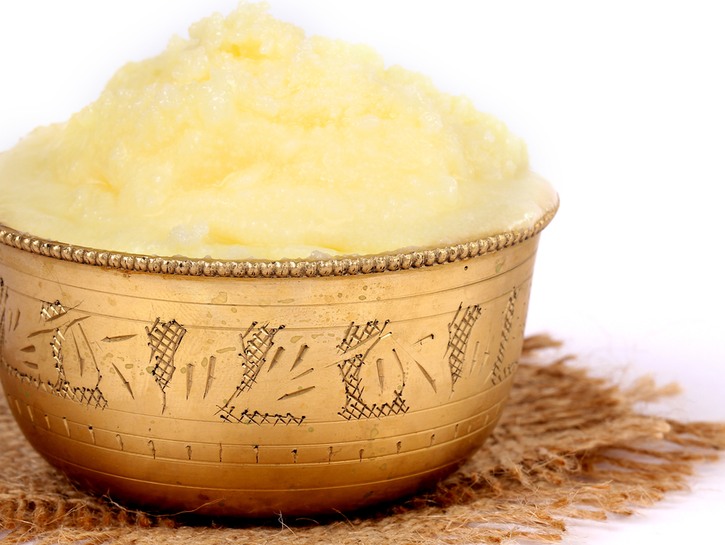Somewhere between a butter and an oil, ghee is becoming increasingly popular as a recipe ingredient, a cooking fat substitute, and supposedly, an addition to coffee. But what is this mysterious dairy topping, and what makes it different from butter?

Quanthem/Shutterstock
What Is Ghee?
Ghee is a clarified butter variation that originated in India, made by isolating the milk solids and water out of butter. The result is a slightly nuttier, toastier substance made entirely out of milk fat, with a consistency anywhere between an oily solid and a liquid (depending on the temperature of its surroundings). Most basically, ghee is butter that’s had the moisture, proteins, and sugars heated out, leaving only the easy-to-digest butterfat.
The absence of milk solids in ghee gives it a more golden color, in addition to a longer shelf life and higher smoking point than standard butter. Unlike butter, ghee does not need to be refrigerated, though it will last longer if it is.
How Is It Made?
Clarified butter is made by heating unsalted butter over medium-low heat until simmering, causing the milk solids in the butter to separate from the liquid butter and sink to the bottom of the pan. If foam forms on the surface, it is skimmed off leaving just the liquid. Remaining milk solids are strained out of the substance, leaving pure butterfat.
To make ghee, this process is taken one step further. Once the milk solids have been separated from the butter, all of the moisture is simmered out of the butter until any remaining liquids have evaporated and the leftover butterfat has been toasted and browned slightly. This gives ghee a more nutty, caramelly taste and aroma.

IriGri/Shutterstock
How Healthy Is It?
Most of the fat in both butter and ghee are saturated fat, but ghee does contain a lot of short-chain and medium-chain fatty acids which can improve heart health. Ghee is also high in fat-soluble vitamins, like vitamin A, vitamin E, and vitamin D. These vitamins require fat for the body to use them, which is useful since ghee also contains those fats. Ghee is also rich in butyric acid, a fatty acid which nourishes the cells of the intestines, so it can have positive effects on the digestive tract.
The clarifying process used to make ghee reduces the presence of lactose, so those with lactose intolerance or dairy sensitivities may find ghee an effective alternative for that creamy, dairy-based texture. Those with gluten-sensitivity or an autoimmune disease like Crohn’s or IBS may have difficulty absorbing vitamin A, but adding ghee to their diet could help boosting intake.
All of that said, ghee is still high in saturated fat which can clog arteries and lead to cardiovascular disease, so ghee should be consumed in moderation.
Ghee Vs. Butter Vs. Margarine
Ghee and butter are dairy-based products, made from milk or cream. Margarine, on the other hand, is a vegetable oil base and is, therefore, more oily where ghee and butter are creamier. Because ghee is the pure butterfat made from butter, ghee and butter are much more similar than either product is to margarine.
The main difference between butter and ghee is the presence of milk solids in butter where ghee has filtered those out, which makes butter creamier, but is also the reason why butter needs to be refrigerated while ghee does not. Ghee also has a distinctly nuttier flavor and aroma from being browned during heating.

espies/Shutterstock
Ways To Use Ghee
As a dairy-based topping, ghee tastes great when spread on toast, bagels, and popcorn. One of the more viral uses of ghee in recent years has been as a sort of creamer in coffee, particularly as an ingredient in “Bulletproof Coffee“, a mix of coffee, oil, and unsalted butter or ghee that’s said to help your body sustain energy levels throughout the day without crashing.
The lack of sugars and proteins in ghee means it has an extremely high smoke point, and the lack of water makes it an ideal cooking fat for sautéing, deep-frying, and stir-frying.
Recipes Ideas That Use Ghee
- Gluten-free Paleo Lemon Butter Chicken uses ghee, coconut cream, and lemon for a zesty, flavorful entree.
- Succulent Italian Garlic Scallops can be served as an appetizer or with pasta or rice as a main course.
- A great breakfast option, Banana with Ghee & Cinnamon takes only 5 minutes to prepare and calls for only 4 ingredients.
- For a new side option to add to your meal rotation, try vegetarian Spiced Cauliflower.
Can I Use It As A Butter Substitute?
In some cases, ghee can be an effective substitute for butter, while other times not. Ghee can be an alternative to butter when cooking on the stovetop since ghee actually has a higher smoking point than butter itself.
When it comes to baking, recipes that call for butter where a richer, denser texture is desired (such as cakes, cookies, pie crusts, and frostings) may find the texture of their end product altered if they swap out butter for ghee. However, recipes that require melted butter should find ghee a workable substitute at a one to one ratio. When substituting butter for ghee, bear in mind that ghee tends to have a nuttier, more caramelized flavor than standard butter, which may make a difference to the taste of your finished product.
